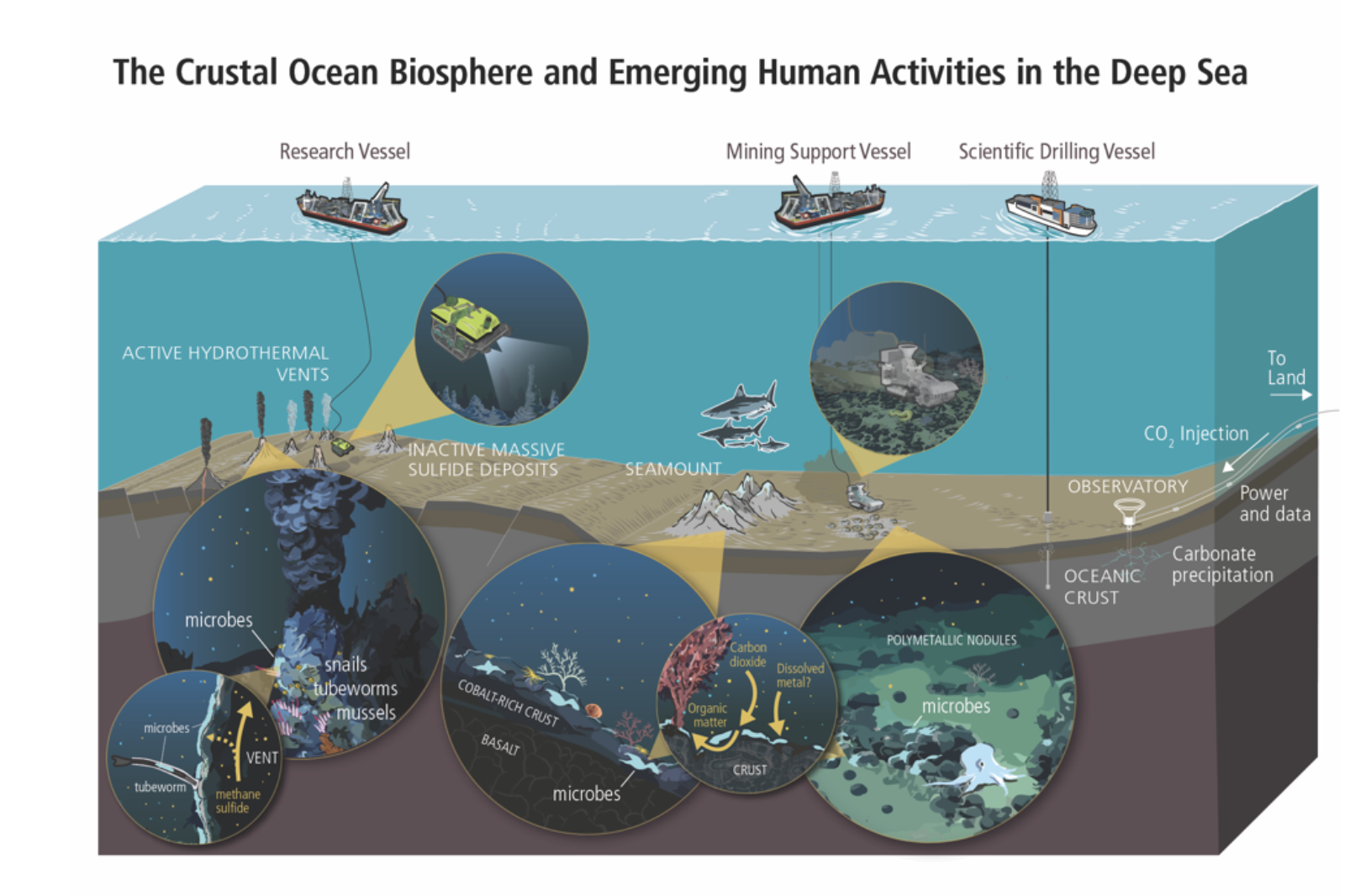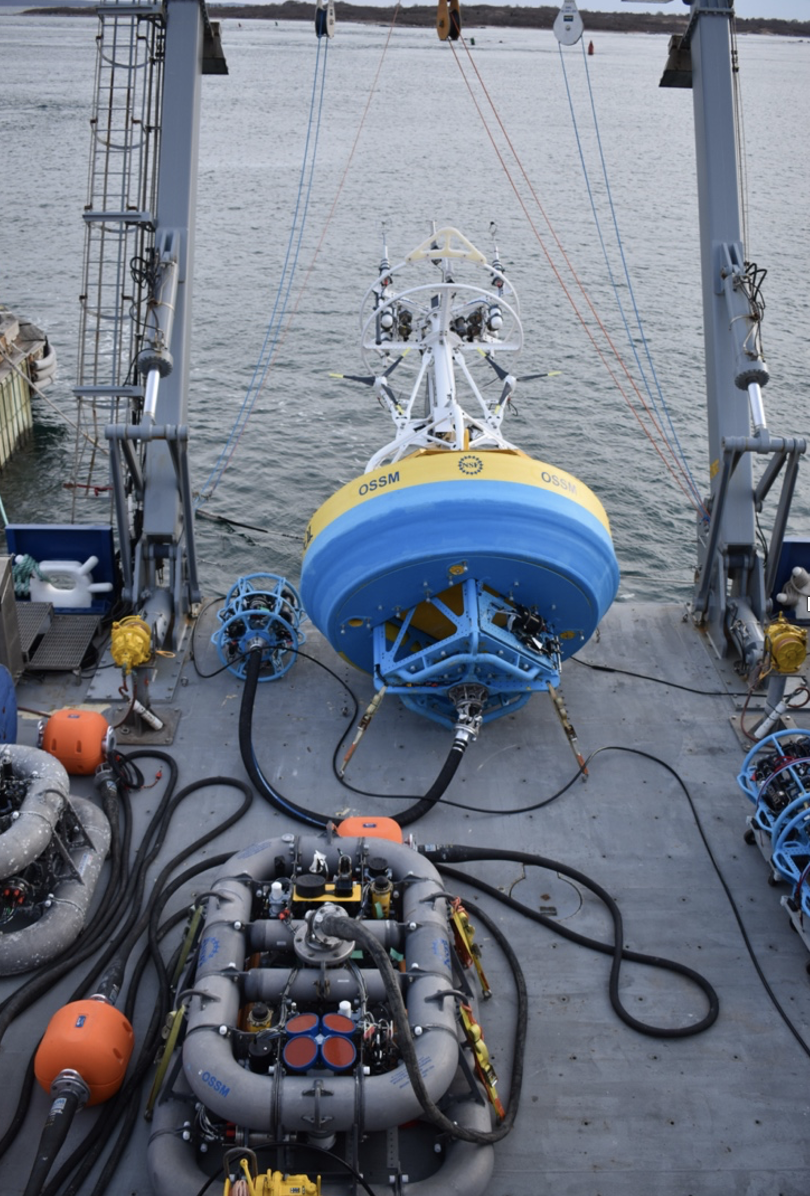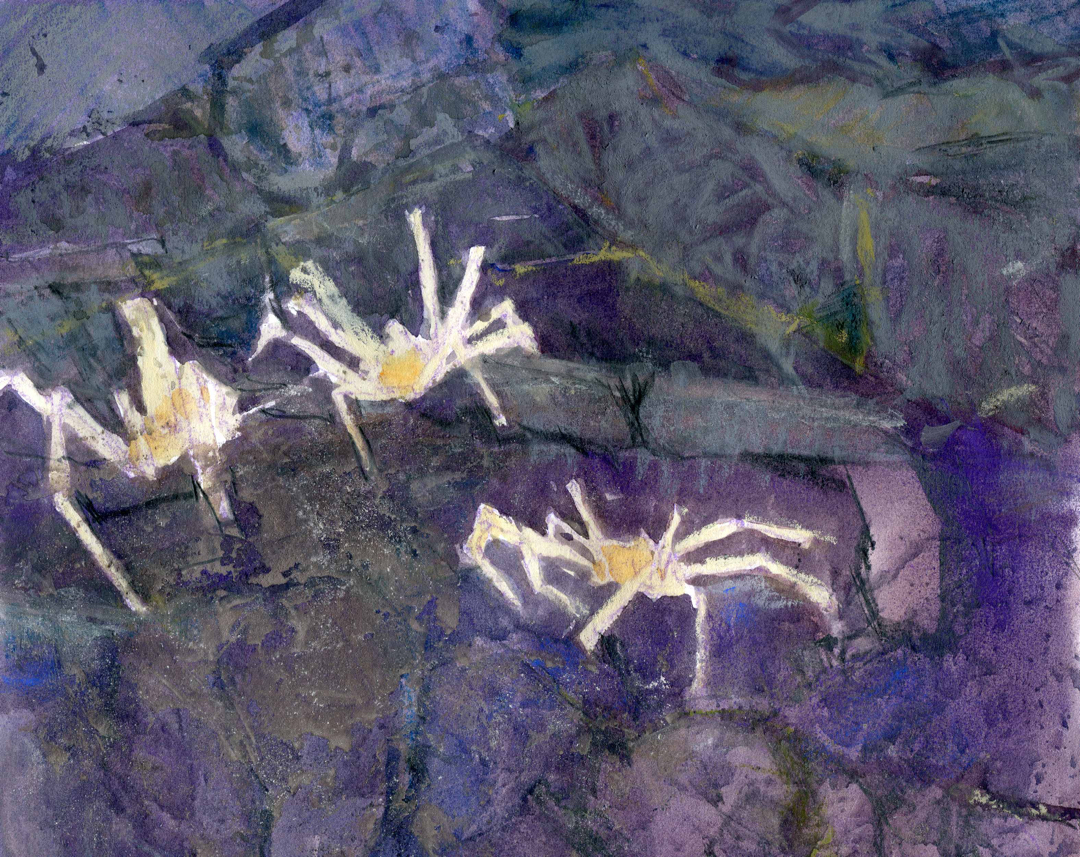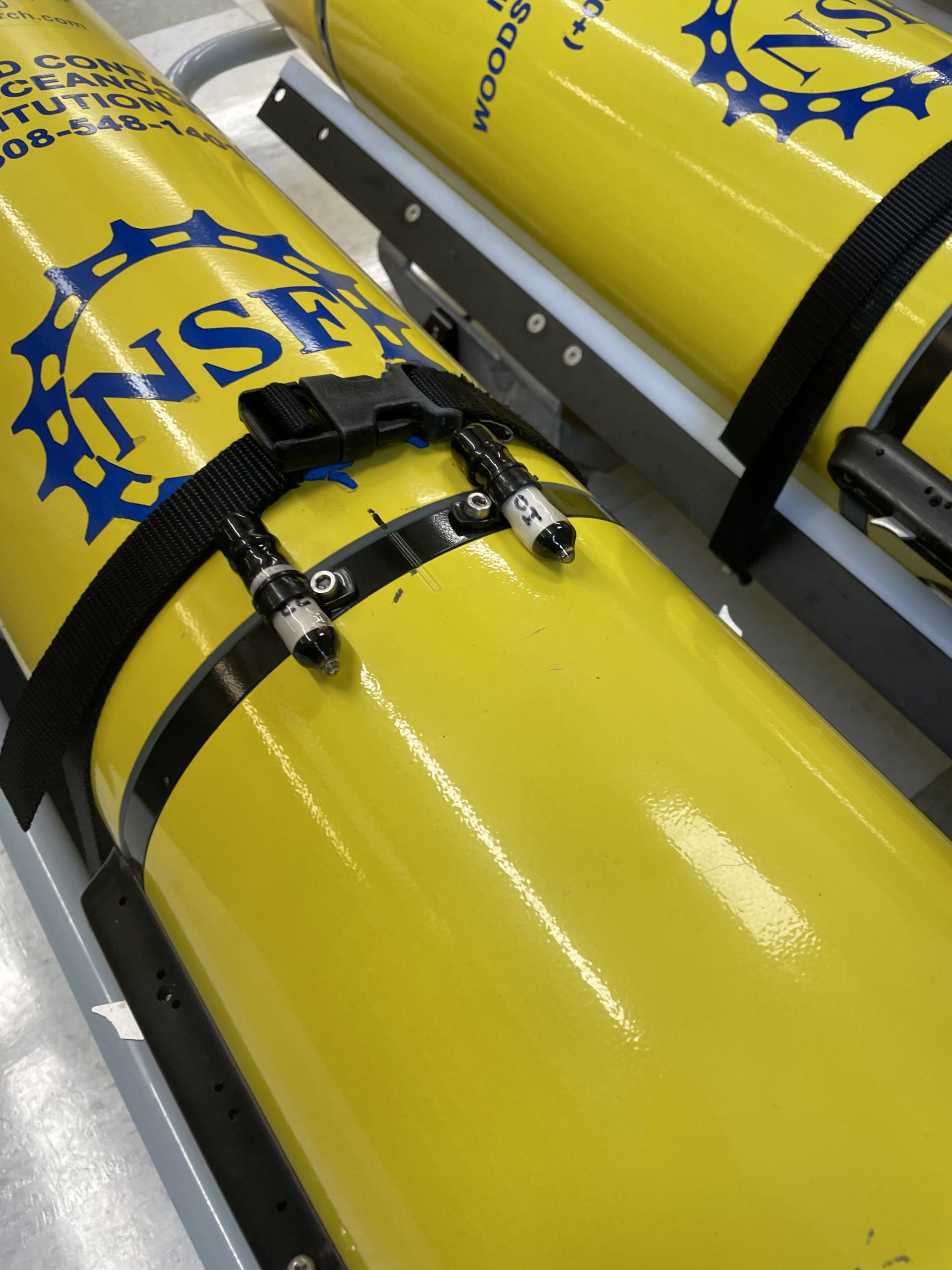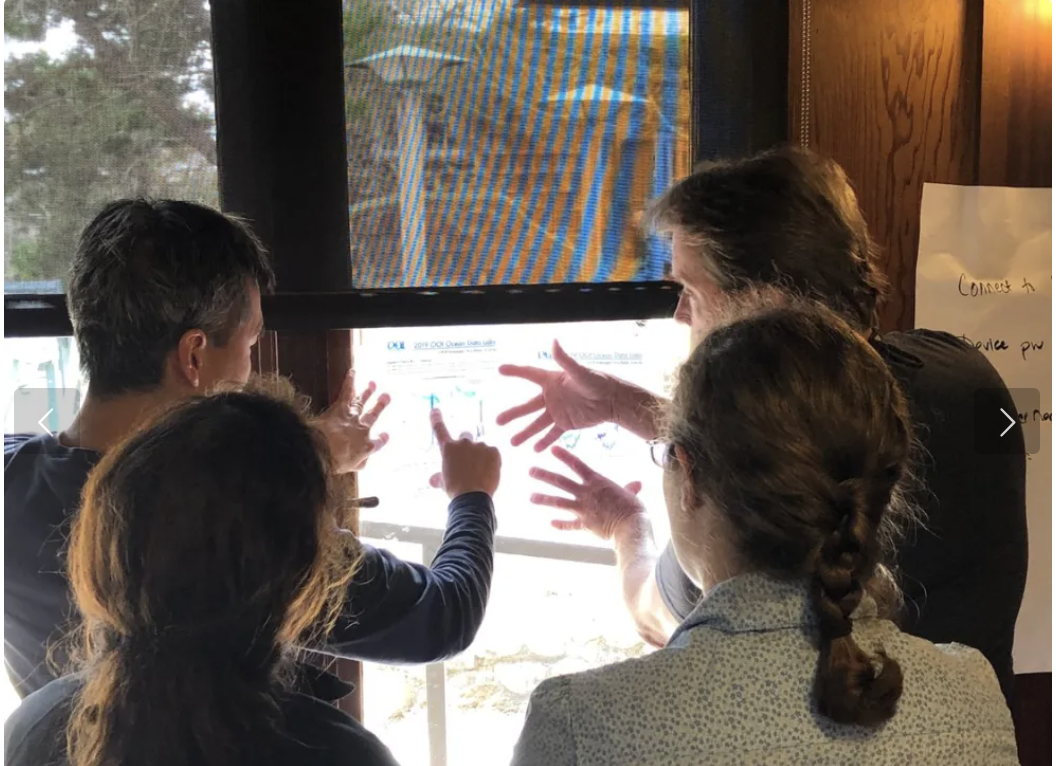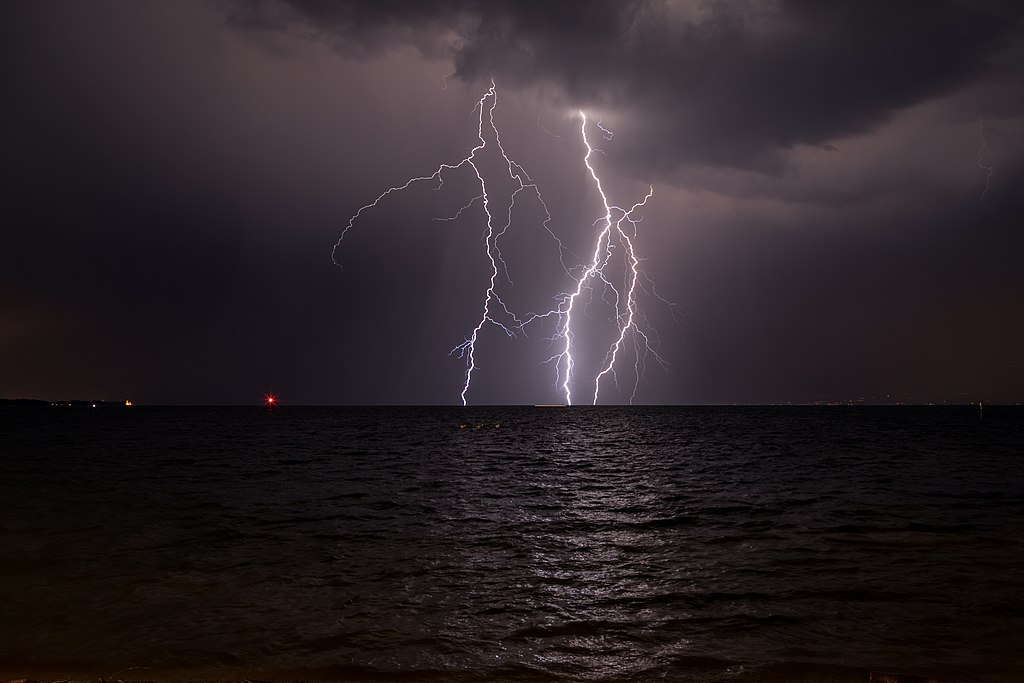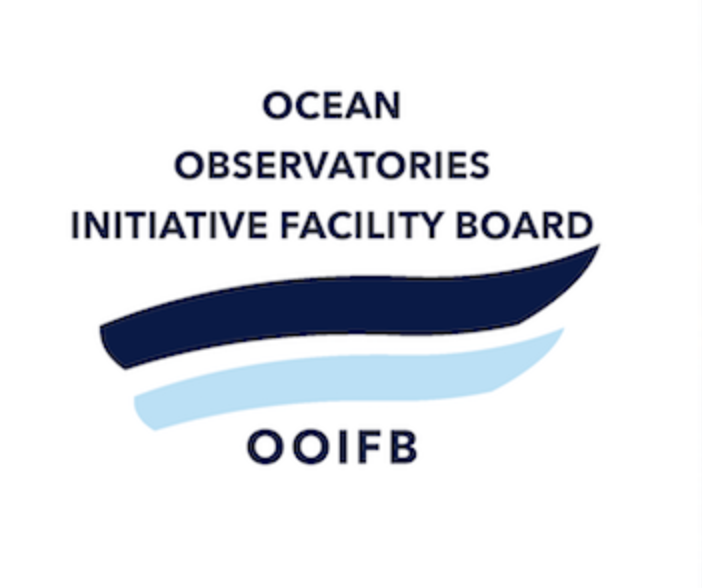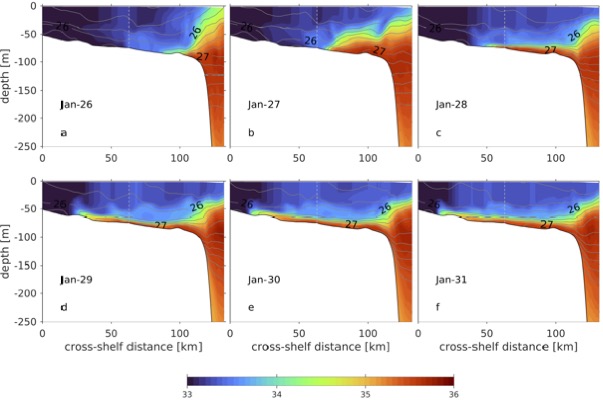News
Improving Remote System Response in Increasingly Hostile Oceans
Wind and Waves and Hydrogen, Oh My!
Improving remote system response in increasingly hostile oceans
This article is a continuation of a series about OOI Surface Moorings. In this article, OOI Integration Engineer Alexander Franks discusses the mooring software and details some of the challenges the buoy system controller code has been written to overcome.
Components of the OOI buoys working in concert make up a system that is designed for deployment in some of the most challenging areas of our world’s oceans. These systems collect valuable scientific data and send it back to Wood Hole Oceanographic Institution (WHOI) servers in near real time. Mechanical riser pieces (wire rope, and/or stretch hoses) moor the buoy to the bottom of the ocean. Foam flotation keeps the buoy above water in even the worst 100-year storm, while its masthead supports instrumentation and satellite radios that make possible the continuous relaying of data. The software controlling the system is just as important as the physical aspects that keep the system operating.
The system software has a variety of responsibilities, including setting instrument configurations and logging data, executing power schedules for instruments and parts of the mooring electronics, controlling the telemetry system, interfacing with lower-level systems including the power system controller, and distributing GPS and timing. The telemetry system is a two-way communication path, so the software controls data delivery from the buoy, but also provides operators with the ability to perform remote command and control.
[caption id="attachment_22938" align="alignnone" width="745"]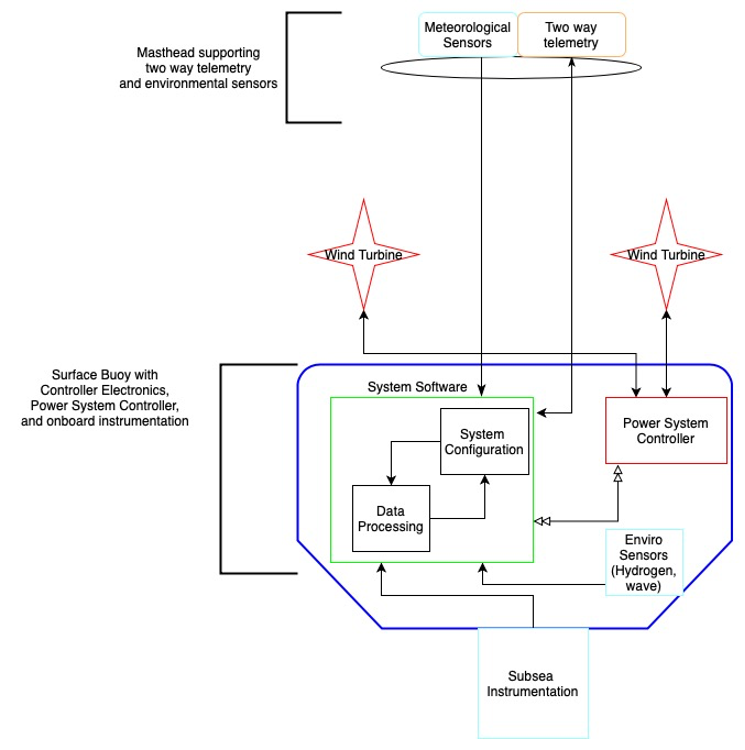 Software flow diagram created by OOI Integration Engineer Alex Franks[/caption]
Software flow diagram created by OOI Integration Engineer Alex Franks[/caption]
The unforgiving environment and long duration deployments of OOI moorings lead to occasional system issues that require intervention. Huge storms, for example, can build waves so high that they threaten wind turbines on the moorings. At the Irminger Sea Array, ice can accumulate so much as to drastically increase the weight of the masthead, and with subsequent buoy motion, risk dunking the masthead and instruments. Other mooring functions require constant attention. The charging system must be monitored to ensure system voltages stay at safe levels and hydrogen generation within the buoy itself is kept within safe limits. Two-way satellite communication allows operators to handle decision making from shore using the most up-to-date information from the buoy.
“Since starting in 2015 and following multiple mooring builds and deployments, I’ve realized that issues can rapidly arise at any time of the day or night. I started thinking about what the buoys can do for themselves, using the data being collected onboard,” Franks said.
One of the game-changing upgrades implemented by Franks was to read environmental data and make automated buoy safety decisions in real-time that were previously performed by the team manually. For example, previously, the team would need to monitor weather forecasts and decide preemptively whether changes to buoy operations were advisable. With recent software changes, the system can now change its configuration based on a variety of sensor inputs. These variables include system voltage, ambient temperature, hydrogen levels inside the buoy well, wind speed, and buoy motion (for sea state approximation). In addition to the software updates, the engineering team redesigned the power system controller. They added charge control circuits and the ability to stop the wind turbines from spinning. The software and electrical upgrades now provide redundant automated safeguards against overcharging situations, hydrogen generation, and turbine damage, maximizing buoy operability in harsh environments.
[caption id="attachment_22946" align="alignleft" width="650"] Onshore engineers are able to keep track of Irminger Sea buoys and instrumentation on this new new dashboard.[/caption]
Onshore engineers are able to keep track of Irminger Sea buoys and instrumentation on this new new dashboard.[/caption]
With a largely independent system, operators also needed a way to easily monitor status of the buoys and instrumentation. The software team created a new shoreside dashboard that allows operators to set up custom alerts and alarms based on variables being collected and telemetered by the buoy. While the buoy systems can now operate autonomously, alerts and alarms maintain a human-in-the-loop component to ensure quality control.
As operations and management of the moorings have progressed, the operations team has found opportunities to fine tune how operators and the system handle edge cases of how the system responds to hardware failures and extreme weather. In the past, sometimes conditions changed faster than the data being transmitted back to shore. This new sophisticated software automates some of the buoy’s responses to changing conditions in real time, which helps to ensure their continued operation even under challenging conditions. The decreased response time to environmental and system events using an automated system, coupled with the ability to monitor and interact remotely, has increased the reliability and survivability of OOI moorings.
Read MoreTwo Artists at Sea
Two artists were aboard the R/V Thomas G. Thompson during this summer’s OOI Regional Cabled Array VISIONS’21 cruise. Undergraduate student Genevieve Kent was leaving the Thompson for Leg 1 of the four-week cruise. Professional artist and lifelong learner, Catherine Gill, was was onboard for Legs 3 and 4 of the summer expedition, including an extra two days at sea while the Thompson was diverted for a rescue mission of two Ocean Exploration Trust remotely operated vehicles (ROVs).
While their physical paths didn’t cross aboard the ship, each spent their time similarly while onboard – serving as a member of the scientific party, taking regular shifts to ensure samples were collected and underwater footage from the ROV Jason was catalogued and archived. They also spent whatever free time they had capturing their experiences in creative endeavors.
Catherine Gill
Because of space limitations on the ship, Gill came equipped with only those supplies that would allow her to draw and paint in very limited space. As a plein air painter, Gill has painted everywhere from in a kayak to in the forest canopy, so she knew what kind of supplies she would need. She brought with her the basics – a standing tripod easel and a small palette. She also brought with her a very small kit that she could keep on her lap and create 5×7 paintings.
“It’s very busy on these legs, but whenever I could find an hour, maybe an hour and a half, I would find a spot on the ship. And I’d set up and do paintings of whatever was happening, putting the new profiler in or pulling up the old one, or capturing some of the very cool stuff on cameras being broadcast by the ROV Jason,” she said. “’I’m sitting there in the Jason control van and watching these scenes that are amazing. There’s different sea life coming from all over the place. The ROV lands on the bottom and you see chimneys and all of the amazing sea life that is down there. It was just incredible.”
Gill painted as things unfolded aboard the Thompson and took screen shots of Jason scenes so she would have a point of reference later on. Regional Cabled Array Principal Investigator Deb Kelley also provided Gill with Jason video that Gill took home to her studio to create bigger paintings of the sea life and Jason operations after she left the ship.
But Gill recounted that she was most at home aboard the ship, painting the experience in real time in “plein air.”
“Because I paint on location, not just from photographs, I know there’s a real difference when you paint from life than when you paint from a photograph. The marks you make are more convincing. If you feel the cold, if you’re aware of the silence, if the wind is blowing on you, you give your painting more than just what your eyes can see,” she explained. But I couldn’t get down to the seafloor to actually paint on location, so having access to video is the next best thing. Having high-definition video to paint from, I can get the feel of what that weird fish is doing, better understand the complexity of those tube worms and deep-sea critters all moving and doing their things, and watch that hydrothermal vent smoking and interacting with the seawater.”
Gill created 13 drawings and paintings while onboard. After her return, she has created another eight to 10 larger-scale paintings. More of her work can be seen on her website, Instagram, and Facebook (Catherine Gill).
Genevieve Kent
Kent, a third-year undergraduate student studying marine biology at the University of Washington, merged her passion for marine science with her artwork while aboard the Thompson. Her interest in marine science was sparked during a seminar class on hydrothermal deep sea vents taught by Kelley. Kent took advantage of the opportunity to participate in a shipboard experience that she learned about in this class to see if she really wanted to pursue a career in marine science.
Kent was accepted to participate in VISIONS’20, but student participation was postponed until 2021 due to COVID restrictions. So, she jumped at the opportunity to sail on the Thompson a year later as part of the VISIONS’21 student contingent.
Her favorite part of the experience was doing shifts in the control van, where her job was to log everything that was happening with Jason as it was used to recover and deploy equipment plugged into the Regional Cabled Array. “I really liked being able to be a part of what was happening. It reminded me a lot of when I was a stage manager for live theater, being in the hot seat and you have to know your role in everything. But it was also really amazing to watch the monitors in real time and see all that was happening there, live and being a part of it.”
Kent works in many mediums from water colors to acrylic paints, to markers, but for this project she chose water colors because they fit the theme of the ocean and can help evoke its many changing moods. While Kent is not a professionally trained artist, she is naturally talented. She used her time in the control van to sketch with colored pencils and capture images of marine life on the bottom that she painted when she returned to her in-home studio.
Once home from the cruise, Kent immediately sat down and started to capture her experiences in watercolors. She used her sketches and images as source material. She is spending as much time as possible on her artwork, as she resumed classes and labs as a full-time student. She has completed several paintings of marine life and has many others in varying stages of completion. Kent can be contacted here.
Plans are in the works to have both artists show their creations at an exhibit at the University of Washington later this spring. A sneak preview is provided below:
[gallery size="large" ids="28987,28988,28989,28990,28991,28992,28993,28994,28995,28996,28997,28998,28999,29000,29001"]
Read More
Tracking Fish with Acoustics
New RAFOS Ocean Acoustic Monitoring (ROAM) tags have recently been designed to allow geolocation of underwater assets, including pelagic fishes, over large areas in the ocean and even deep into the ocean’s twilight zone.
[caption id="attachment_22879" align="alignleft" width="350"]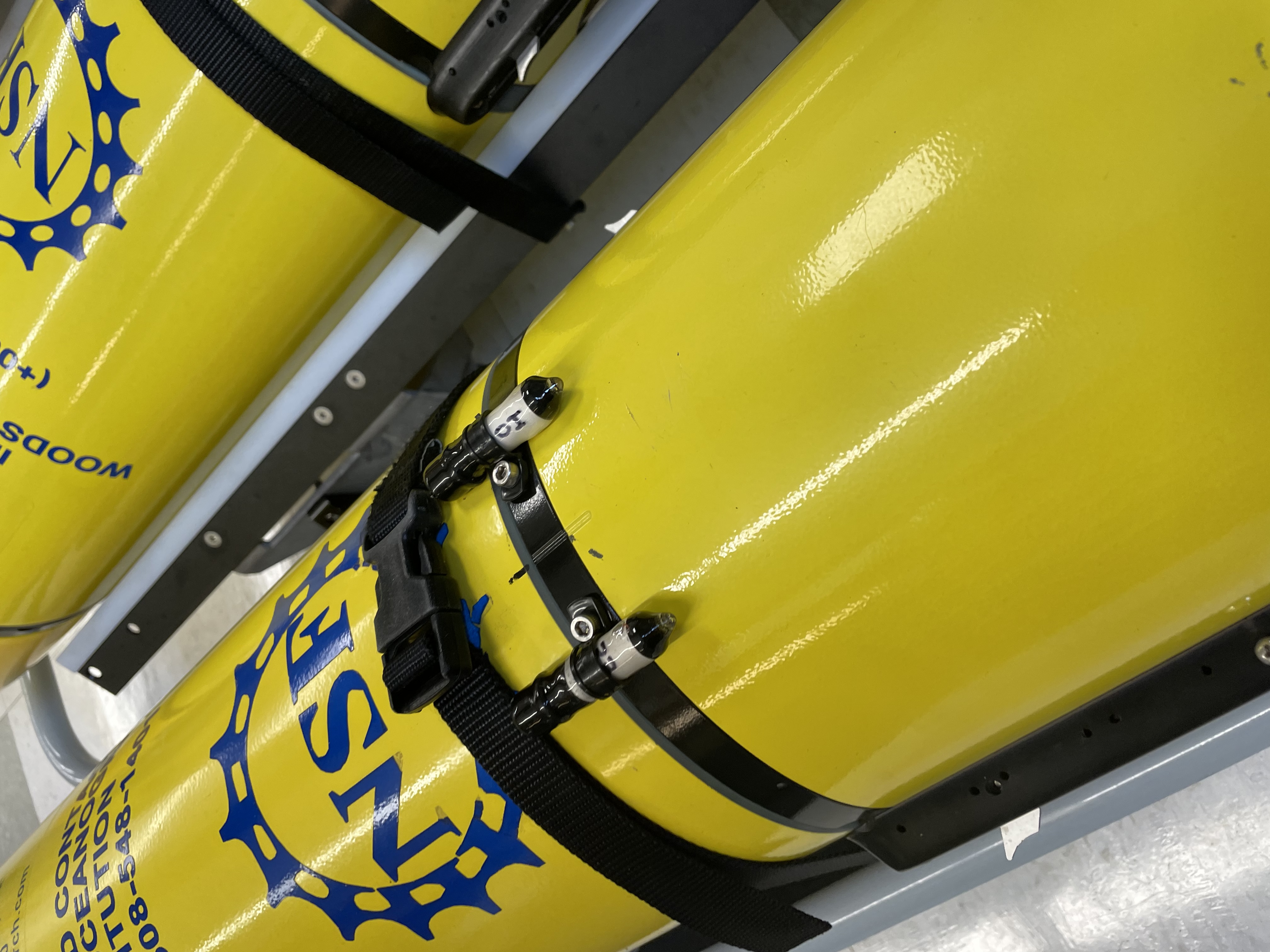 The ROAM tag is small (30 mm x 10 mm) and light enough (8 gm in water) to be attached to an ocean glider with no adverse impacts on performance. Here are two ROAM tags attached to OOI test glider 363 before deployment from the R/V Armstrong during the Pioneer 17 cruise. Credit: ©WHOI, Diana Wickman.[/caption]
The ROAM tag is small (30 mm x 10 mm) and light enough (8 gm in water) to be attached to an ocean glider with no adverse impacts on performance. Here are two ROAM tags attached to OOI test glider 363 before deployment from the R/V Armstrong during the Pioneer 17 cruise. Credit: ©WHOI, Diana Wickman.[/caption]
An opportunity to test the new ROAM tags arose in conjunction with the October 2021 Pioneer Array mooring service cruise. “We had recently deployed moored sound sources in deep water between Cape Cod and Bermuda,” said Simon Thorrold who, with University of Rhode Island colleagues Melissa Omand and Godi Fischer, is leading the ROAM fish tag development. “One of our goals was to determine whether tagged fish near the continental slope south of New England could be detected using these distant sources.” Thorrold reached out to the OOI team to see if there was potential for a short-term test at the Pioneer Array site, located 75 nautical miles south of Martha’s Vineyard at the shelf-slope interface.
OOI Project Scientist Al Plueddemann and the OOI glider team determined that a glider test planned during the mooring service cruise in late October would be happening at the right place and the right time to be useful for testing the acoustic tags. “This technology is something we would like to consider for OOI, and in particular for the Pioneer Array in its new southern Mid- Atlantic Bight location,” said Plueddemann, “so the potential for a test was of interest to us.”
The glider team determined that the small (30×10 mm), light (8 gm in water) tags would have no measurable impact on glider performance and could be safely accommodated on the test glider. The tags were mounted to the glider by fitting the tags into plastic loop clamps and then securing the loop clamps to existing threaded holes in the glider hull. During the three-day test deployment, the glider made one dive to 50m, one dive to 200m, three dives to 500m, and approximately 76 dives to 200m.
The glider data and acoustic tag data are being evaluated, and will provide information about fish tag performance and the potential for future use within the OOI arrays.
This article was written by Woods Hole Oceanographic Institution colleagues: Senior Scientist Simon Thorrold and Senior Engineering Assistant II Diana Wickman.
Read MoreFunding Opportunity for OOI Education, Workshops, Training Proposals
To encourage wider use of OOI data by researchers and educators, the Ocean Sciences Division (OCE) of the National Science Foundation is seeking proposals for projects that use OOI data. Funding is available to support workshops, conferences or other training events that introduce researchers and educators to the type of data available through OOI and community tools that have been developed to use that data.
A Dear Colleague Letter (NSF20-047) issued in early 2020 remains in effect.
“We are seeking to support efforts that teach researchers or educators how to use OOI data and tools, that develop additional tools or instructional materials using OOI data or that serve to create communities of practice to use OOI data for multi-investigator, community-driven research, “ said Elizabeth Rom, an OCE Program Director who oversees a number of NSF educational initiatives.
At a recent town hall of the Ocean Observatories Initiative Facility Board at the AGU Fall Meeting, Rom presented a progress report on proposals funded since May 2020. These include:
- Two Ocean Hack weeks held at the University of Washington and Bigelow Laboratory for Ocean Sciences. In 2020, the workshop was virtual, in 2021 the workshop was a hybrid.
- OOI Biogeochemical Data Workshop, which consisted of an online meeting in July 2021 and plans for an in-person meeting for June 2022 at Woods Hole Oceanographic Institution.
- K12 OOI Workshop Series that involves the South Kitsap School District in Washington state and Deb Kelley at the University of Washington. The goals of the workshop series are to develop teacher cohort and lesson plans using OOI data in classrooms. The series launched in early December with virtual and in-person sessions planned throughout 2022.
She also reported on progress in course development, including support of a second cohort of faculty to develop version 2 of the Ocean Data Lab’s online manual, microbial monitoring using OOI RCA remote samplers at Axial Seamount, and development of instructional materials and piloting assessment instruments to explore undergraduate scientific literacy. NSF programs GeoPaths (Pathways into the Earth, Ocean, Polar and Atmospheric and Geospace Sciences) and Research Experiences for Undergraduates (REU) sites also provided opportunities for using OOI data. An initiative to broaden the scope and increase the efficacy of the SERC Discovery System was supported, as were multiple REU student projects in 2020 and 2021.
“While COVID served to discourage in-person meetings and workshops, we were pleased that so many innovative approaches were proposed,” added Rom. “Hopefully in 2022, we will have opportunities to for virtual, hybrid and in-person workshops, and certainly the innovation of this community will shine through.”
Two- and four-year U.S. institutions of higher education and U.S. non-profit non-academic organizations are eligible to submit proposals. Proposals may be submitted at any time, but Principal Investigators are encouraged to submit at least six months prior to the planned event. Submission details are available here. While the DCL refers to Fiscal Year 2020, it continues to be in effect until canceled.
Read MoreCall for Lightning Talks at OOIFB Town Hall
The Ocean Observatories Initiative Facilities Board (OOIFB) will host a Town Hall at the 2022 Ocean Sciences Meeting (OSM) on Friday, February 25th from 12:00 pm to 1:00 pm Eastern Time. The meeting will be fully virtual. The community will have the opportunity to hear the latest information about the OOI facility, Pioneer Array relocation plans, early career scientists’ activities, and education updates.
The Town Hall also will include a series of lightning presentations where scientists are invited to present one slide in one minute explaining how they have used (or plan to use) freely available observatory data in their respective research. OOIFB invites all to consider presenting a slide in the lightning session.
Time during the Town Hall is limited and about six lightning talks will be scheduled during the Town Hall. However, all submitted lightning talks will have the opportunity to be presented during the Ocean Sciences Meeting. The OOIFB has teamed with the OOI’s virtual booth team to offer a time slot during the meeting to highlight all of the lightning talks.
Sign-up Now to Present a Lightning Talk – If you are using observatory data and wish to present a lightning talk during the Town Hall, please apply using the: LIGHTNING TALK FORM by February 9th. From the applications submitted, OOIFB will select six lightning talks for the Town Hall that can highlight the exciting research that is being done across the entire OOI Facility.
Funding Available for OSM Registration Fee – Please note, all participants and presenters during the OOIFB Town Hall must be registered for the 2022 Ocean Sciences Meeting. Funding is available to offset the registration fee for students and early career scientists (ECS) who are presenting a lightning talk. Funding is limited and the first 20 student/ECS applications will be considered for reimbursement. The Lightning Talk application form includes space for requesting OSM registration reimbursement.
The workshop is aimed at researchers who are using or are considering using OOI data and/or adding instrumentation to OOI infrastructure and educators at all levels interested in using data from the OOI’s Arrays. Hope to see you at the OOIFB Town Hall!
Event: OOI Facility Board Town Hall
When: Friday, February 25th from 12:00 pm to 1:00 pm Eastern Time
Lightning Talks: Apply online. The form will be open until February 9th.
Where: Participation will be virtual and available to individuals registered for the Ocean Sciences Meeting.
The Town Hall agenda and additional details are available here.
OOI Data System User Survey: Opportunity to Provide Feedback
The OOIFB Data Systems Committee needs your help in evaluating new Ocean Observatories Initiative (OOI) data systems. In 2019 the OOI Facility Board’s Data Systems Committee (DSC) conducted a survey to learn how the OOI could better serve data to users. In response to the feedback received, the OOI program developed the Data Explorer, a refined and more capable interface for finding and accessing data. Now, the DSC is interested to hear your thoughts on this new data system, as well as the other available systems, and to uncover potential ways of improving data access for users.
OOI’s Contributions to Understanding the Changing Ocean Cited in Boston Globe
Woods Hole Oceanographic Institution Research Scientist Glen Gawarkiewicz cites how he uses OOI data to figure out what is happening in the changing ocean in an article on that appeared on the front page of the Boston Globe on December 28, 2021.
In a record-breaking year of weather, signs of a changed world.
[caption id="attachment_22801" align="alignnone" width="1610"]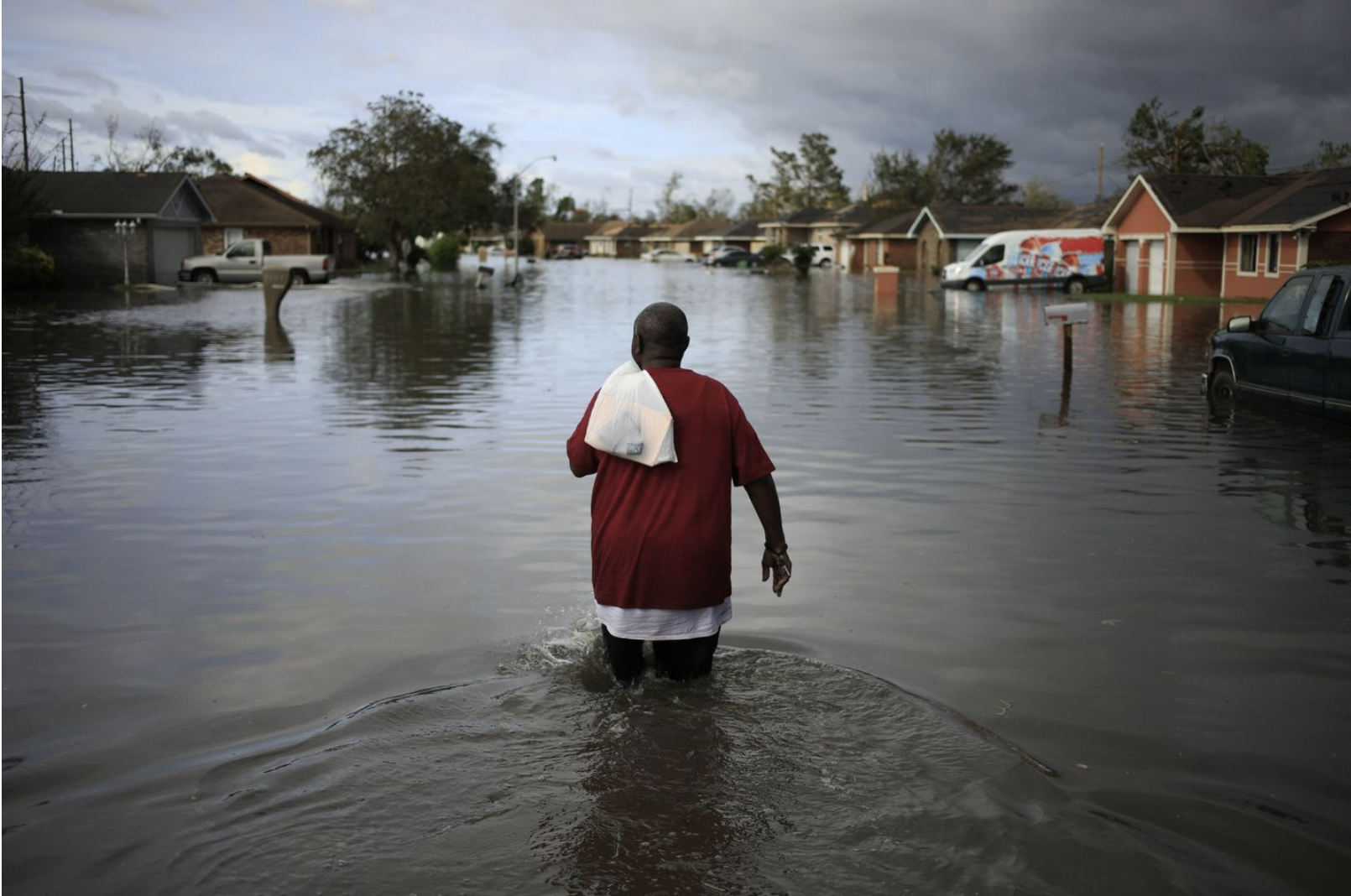 A resident walked through floodwaters left by Hurricane Ida in La Place Louisiana on August 30, 2921. Credit: Luke Sharrett/Bloomberg via the Boston Globe.[/caption]
Read More
A resident walked through floodwaters left by Hurricane Ida in La Place Louisiana on August 30, 2921. Credit: Luke Sharrett/Bloomberg via the Boston Globe.[/caption]
Read More Gulf Stream Species in Cold North Waters Spur Scientific Discovery
In early 2017, something strange was going on in the waters off the coast of Rhode Island. Fishers were pulling up a very unusual bycatch of Gulf Stream flounder and juvenile Black Sea bass. The Gulf Stream flounder are typically found in warmer waters, and while black sea bass are a very common fish, they are typically not present in cold water in the middle of winter, particularly not their juveniles. The fish coming up in their nets were so unusual for this time of the year, that a member of the Commercial Fisheries Research Foundation (CFRF) sent a photograph to Woods Hole Oceanographic Institution (WHOI) scientist Glen Gawarkiewicz asking what he thought might be causing these tropical fish to end up in cold New England waters in the dead of winter.
[media-caption path="/wp-content/uploads/2021/12/Flounder-1.jpeg" link="#"]Anna Mercer from CFRF sent this photo of Gulf Stream flounder and juvenile Black Sea Bass to Glen Gawarkiewicz, launching an investigation that resulted in three research papers.[/media-caption]
“One fun thing about my relationship with the fishing community now is if they see unusual things, they send them to me. And then I’ll usually go right to the Pioneer Array website, look at the data and see if there’s some kind of a story, I can tell about the oceanographic conditions that might have given rise to unusual features, or unusual fish,” said Gawarkiewicz.
This query about an unusual catch prompted a scientific investigation whose results were recently published in the Journal of Geophysical Research: Oceans. The authors, WHOI colleagues Ke Chen, Glen Gawarkiewicz, and Jiayan Yang, identified for the first time the cause and multi-faceted dynamics at play in a subsurface marine heat wave (a high temperature anomaly event), expanding views of contributing factors to such ocean-altering events. They pinpointed the interplay between smaller scale cyclonic eddies and warm water intrusions that created an anomalous marine heat wave.
The research team started with the traditional hypothesis that warm core rings at the shelf break were pushing warm and salty water onto the shelf towards shore, generating a marine heat wave. But after analyzing the fishing data and oceanographic data from the Pioneer Array, the team was not able to pinpoint the exact process causing the marine heat wave. Chen took up the challenge and created a numerical model simulating ocean conditions during November 2016-February 2017.
The model, which was at an exceptionally fine scale of 1 kilometer resolution, captured what the team saw from the data. The model revealed warm core rings were not solely responsible for the increase in temperature of water moving into shore, but rather the heated, salty water was being moved by a combination of previously overlooked smaller scale cyclone-like eddies (circular currents of water) in the periphery of the warm core ring. The model also revealed a very persistent wind blowing from west to east in late January 2017 that worked jointly with the cyclonic eddies that had already changed the outer shelf conditions.
The winds brought the warm and salty water from the shelf break to around 50 meters depth for a distance larger than 100 kilometers over five-six days. The intrusion was localized. It moved along the slope, climbed up the shelf, and moved onshore.
“So this remarkable intrusion was really different from what has been known of the dynamics contributing to onshore intrusions for this region, “explained Chen. “It is a very new and exciting finding that such intrusions can be a combination of smaller scale eddies and wind causing warm water intrusions at a particular location.” The model shows the complexity of such intrusions that may result from multiple sources and conditions. “It provides a more complete picture of conditions and how they might ultimately impact what fish are caught and where they are caught,” added Chen.
Gawarkiewicz concluded, “The Pioneer Array has just worked wonders for our relationship with the fishing industry and has also allowed us to see ongoing changes in this ocean region that keep accelerating. The Pioneer Array just brilliantly combines both the cutting-edge research, like the modeling Ke is doing, with the real dire societal need of identifying and ultimately understanding changing ocean conditions. I only wish that we could have a Pioneer Array, basically in every region of the country.”
____________________________________________
See Boston Globe article on December 28, 2021 for other ways OOI data are contributing to scientific understanding of the changing ocean.
Read More
New Controller Latest in OOI Innovations
Having equipment in the water around the clock for six months at a time provides many challenges for the land-based OOI engineering team charged with keeping the equipment operational so there is a continual flow of data to shore. Maintaining consistent, reliable power for the ocean observing equipment is at the top of this list of challenges.
OOI’s data-collecting instruments attached to the moorings run on batteries charged by renewable wind and solar energy. OOI is in the process of replacing the current solar panels with new panels that are more efficient at generating energy, even when shaded. To supplement this upgrade, the OOI arrays are also being outfitted with a brand-new solar controller to manage the energy going into the batteries. Like with the new solar panels, OOI engineers looked for a controller that was available commercially for easier repair and replacement.
“What was important to us was finding a way to use these new solar panels in the best, most optimal way,” said Woods Hole Oceanographic Institution (WHOI) engineer Marshall Swartz. “We looked for a company that would help us specify and build a customized algorithm for a controller that would optimize the functionality of the panels by taking into account battery temperatures.”
[media-caption path="/wp-content/uploads/2021/12/DSC0486-2.jpeg" link="#"]Buoys get quite the workout when they are in the water for six months and more. Powered by wind, solar, and batteries, OOI has recently improved the way energy from the solar panels is managed with new controllers. Credit: ©WHOI, Darlene Trew Crist. [/media-caption]
Some larger, older controllers can consume up to 3-5% of the energy coming into the device, but the new controller is smaller and more efficient, helping to optimize the amount of energy harvested.
Temperature conditions play a big role in how effectively the energy is managed. Changing battery temperatures require the controller to adjust its charge settings to maintain battery life and capacity. The controllers used on OOI moorings sense battery temperature and automatically adjust to assure best conditions to assure reliable operation.
“It’s really essential for us to maintain the proper charge levels for existing temperature conditions,” said Swartz. The OOI buoys encounter a wide range of temperatures: from subfreezing temperatures up to 40°C (over 100°F) when a buoy is sitting in the parking lot before it is deployed. When the buoys are deployed, water temperatures can vary widely from -1 to 33°C (~30 to 91°F), depending on seasonal conditions.
The new controller automatically regulates the amount of electricity going into the battery under such varying temperature conditions. If the wind turbines are generating more energy than the battery needs, for example, the controllers direct excess power into an external load that dissipates heat and adds resistance to the spinning of the wind turbines, preventing the turbines from spinning too fast, possibly damaging their bearings.
“As parts of the OOI infrastructure need replacing or to be upgraded, this offers us the opportunity to find more efficient, and often times, off-the-shelf, less-expensive replacements that will help us keep the arrays functioning and data flowing,” Swartz said. “It’s a winning combination for all parts of the operation.”
Read More
2022 COBRA Early Career Fellowship and Deep-Sea Expedition Planning Master Class
The Crustal Ocean Biosphere Research Accelerator (COBRA) is pleased to announce a paid training opportunity in the Spring of 2022 that is open to international early career participants. Participants in the COBRA Early Career Deep-Sea Expedition “Master Class” will receive training in deep-sea expedition planning from start to finish. This course will equip participants with the skills and tools to successfully design, propose, and execute deep-sea oceanographic field research, with a collaborative, just, equitable, diverse, and inclusive approach. Example topics to be covered in the Master Class include: Assets for conducting deep-sea research and exploration; Funding and proposal writing tips; Developing concepts through respectful and reciprocal engagement with others; Cruise preparation how-to; At-sea operations overview; Telepresence-enabled exploration and research; Permits and Reports; Data Management.
The COBRA Fellowship program is intended to help to create a larger, more diverse pool of talent engaged in leading deep-sea research that addresses societal needs. COBRA has a goal of having a balanced representation of US-based and international participants across the early career spectrum that bring diverse experiences and perspectives to the class. Previous experience with deep-sea research or policy is not required. COBRA defines “early career” as senior graduate students, postdoctoral scientists, junior faculty less than 10 years from their terminal degree, and other junior professionals, such as an early career employee of a government, NGO, or industry. Fellows are eligible to receive a $2,000 USD stipend to support their participation in the fellowship and virtual Master Class, which is offered free of charge.
The application period is open through January 15. More details and the online application form can be found here. Questions are welcome via email to cobra@bigelow.org.
COBRA is an international research coordination network funded by the US National Science Foundation. COBRA’s mission is to accelerate research on the structure, function, resilience, and ecosystem services of the crustal ocean biosphere to generate new knowledge and inform decision-making, particularly related to deep-sea mining and subseafloor carbon sequestration. If you’d like to learn more, COBRA Directors will be providing an overview on Friday January 7 12:30PM EST (GMT-5) as part of the C-DEBI monthly seminar series. These seminars are open to anyone to participate by registering here.
